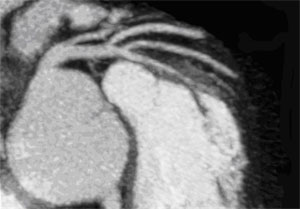CT angiograms
Definition
In recent years, CT scanning (computed tomography) has advanced rapidly to the point where it is becoming a valuable tool in the diagnosis and management of coronary artery disease. This non-invasive,specialised “CAT” or CT scan that takes multiple high resolution images of the beating heart to provide very detailed images, thereby increasing the accuracy of the diagnosis The images of the arteries will enable the cardiologist to determine the extent of atherosclerosis (hardening of the arteries) and the severity of the disease. Traditional coronary angiography, although the “gold standard” currently, is a fairly gross test in determining the extent of disease and often it underestimates extent of disease. CT angiography on the other hand however, is a safe and quick way of determining both, which will help guide the patient’s diagnosis and therapy.

CT angiogram showing the origin of the left coronary circulation and its branches. Note the detail within the arteries and associated cardiac structures including the aorta.
CT angiography is also used to determine the calcium score, or the degree of calcification in coronary arteries. Studies have shown that the coronary calcium score closely correlates to the degree of coronary artery disease and the likelihood of a major cardiac event. This test is quick and painless. It is sometimes used before a coronary angiogram is recommended.
CT angiography may be performed in both high- and low-risk patients. Because this technology is still rapidly evolving, clinical standards for its use remain somewhat controversial in the medical community.
How the test is performed
The test is best performed in a centre that that has qualified cardiologists experienced at reading CT scans of the coronary arteries. The patient arrives at the centre and has an intravenous line inserted into a lage vein in the arm. The patient then lies on a CT scanner bed and instructions on breathing technique which is a crucial aspect of attaining high quality images are explained to them before imaging takes place. A “test” shot of contrast is delivered through the IV cannula before the main scan. Intravenous beta blockers are also delivered to slow the heart rate for better image quality acquisition. The actual scanning takes a little more than 10 seconds but the preparation for the patient will take longer. The results will need to be processed in the first instance and the cardiologist may take a day or two to report back with the result.
How the test will feel
The patient may feel a warm sensation as the contrast is delivered into the vein otherwise there should be minimal abnormal sensations.
Why the test is performed
The test is particularly useful when a patient is concerned about their risk of having heart disease, particularly in the context of risk factors like smoking or family history of heart disease. Other indications include chest pain typical or atypical of ischaemia, particularly if the pain has been persistent or recurrent and traditional investigations cardiac testing has not been helpful. Many other indications are listed by the American College of Cardiology and the American Heart Association (see below).
What abnormal results mean
An abnormal result will be discussed with you as soon as it is available. With respect to scanning for “blocked or hardening of the arteries” (or atherosclerosis) we will indicate to you the extent of disease (if any) and the severity of the blockages if present. Characteristics of the disease displayed on the CT scanner enable the experienced cardiologist to determine whether the blockages are new, old or mixed. This in addition to the location of the blocked arteries and their severity will indicate whether the patient is in immediate danger. All of these issues will be explained to the patient after the scanner, when the patient returns to the cardiologist for a complete analysis of the results and follow-up plan.
Questions for your doctor
Preparing questions in advance can help patients to have more meaningful discussions with their physicians regarding their conditions. Patients may wish to ask their doctor the following questions related to a coronary angiogram:
- What can a coronary angiogram tell you about my condition? What, specifically, would this test be checking for in my case?
- What type of results would you expect? What type of results would you consider abnormal?
- Where would the test be conducted?
- Are there any risks involved with this type of test that I should be aware of?
- Can this test alone provide you with a diagnosis, or will other tests need to be performed as well?
- Do I have any conditions or characteristics that may influence the results of this test in any way?
- How will I be informed of the test results? What if I have questions about the results?
- How long will it take before I find out the test results?
- Can this test still be performed if I am pregnant? Could pregnancy influence the results?
